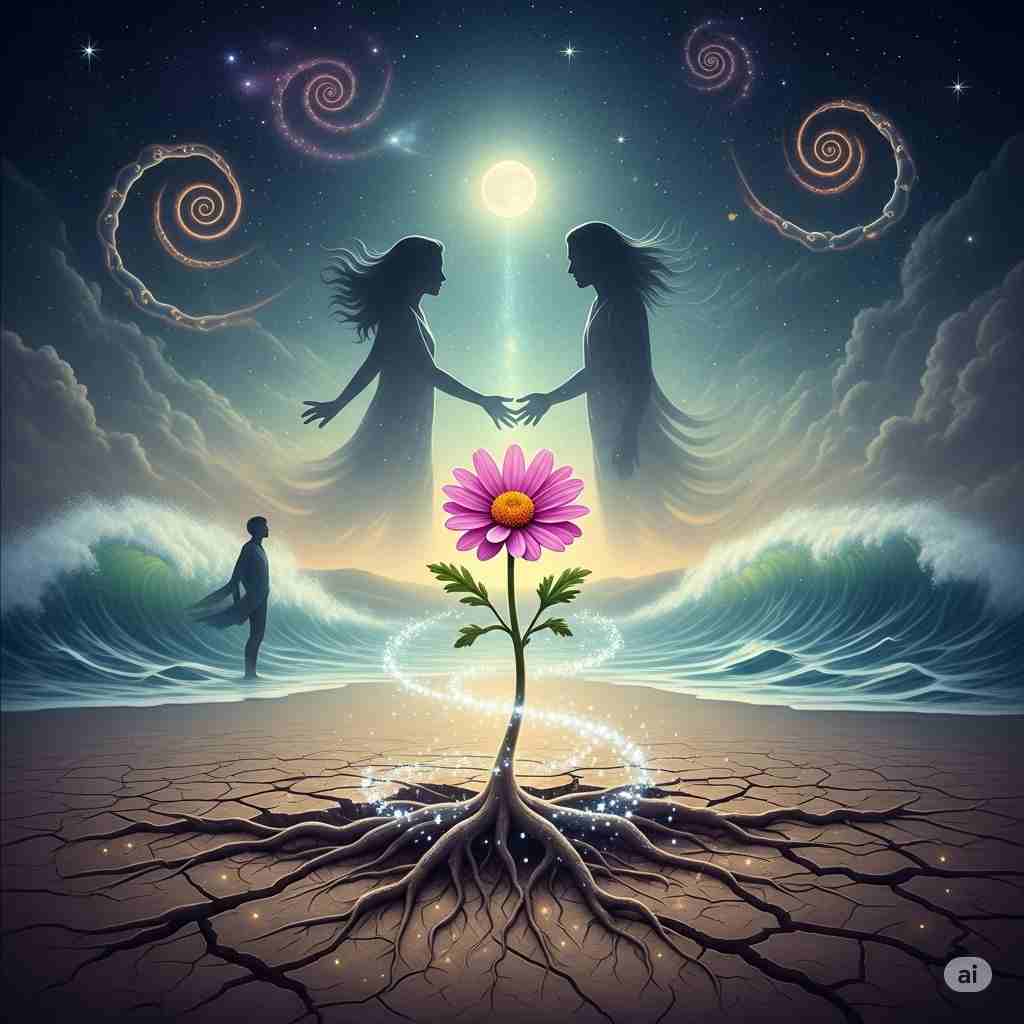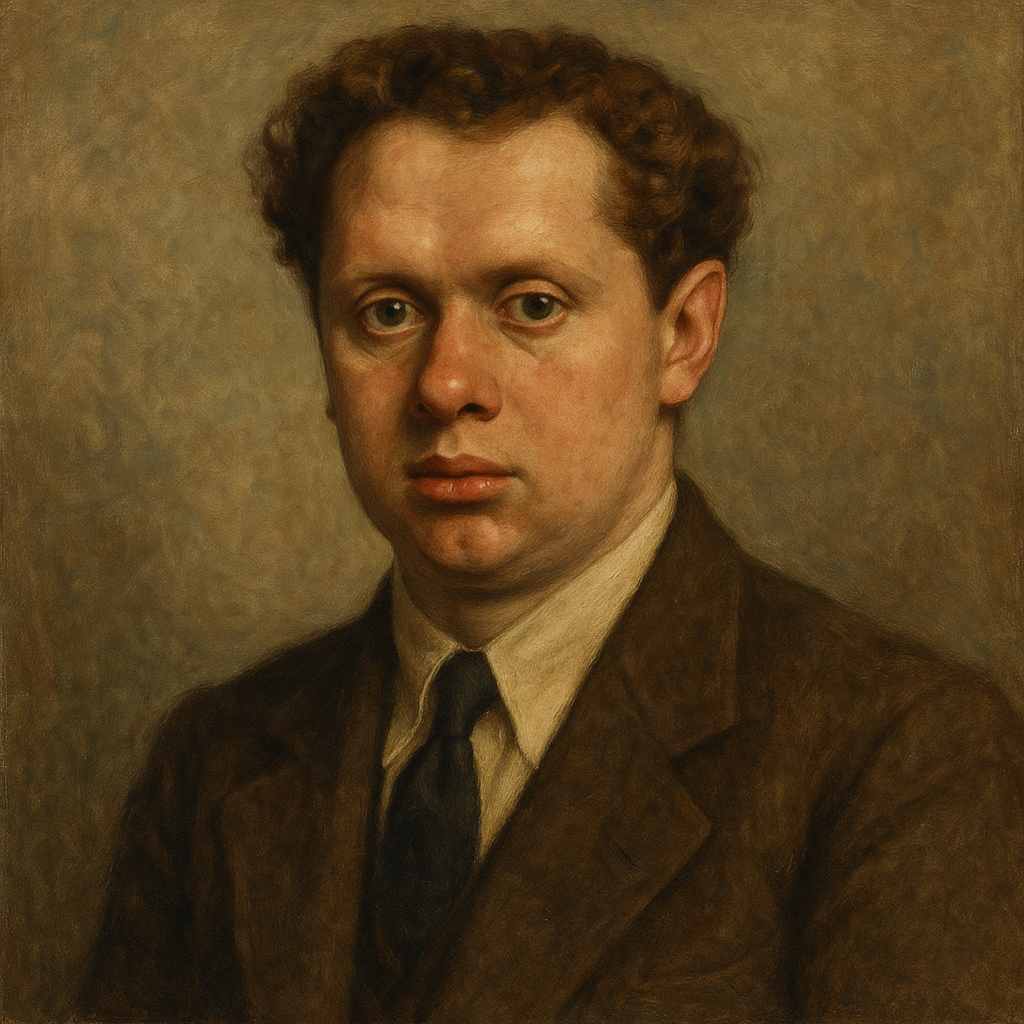And death shall have no dominion
Dylan Thomas
1914 to 1953

And death shall have no dominion.
Dead men naked they shall be one
With the man in the wind and the west moon;
When their bones are picked clean and the clean bones gone,
They shall have stars at elbow and foot;
Though they go mad they shall be sane,
Though they sink through the sea they shall rise again;
Though lovers be lost love shall not;
And death shall have no dominion.
And death shall have no dominion.
Under the windings of the sea
They lying long shall not die windily;
Twisting on racks when sinews give way,
Strapped to a wheel, yet they shall not break;
Faith in their hands shall snap in two,
And the unicorn evils run them through;
Split all ends up they shan’t crack;
And death shall have no dominion.
And death shall have no dominion.
No more may gulls cry at their ears
Or waves break loud on the seashores;
Where blew a flower may a flower no more
Lift its head to the blows of the rain;
Though they be mad and dead as nails,
Heads of the characters hammer through daisies;
Break in the sun till the sun breaks down,
And death shall have no dominion.
Dylan Thomas's And death shall have no dominion
Dylan Thomas’s And death shall have no dominion (1933) is a triumphant meditation on mortality, resilience, and the transcendent power of existence beyond physical decay. Written when Thomas was only nineteen, the poem exhibits a precocious command of imagery, rhythm, and thematic depth, blending Christian eschatology, pagan symbolism, and modernist existentialism into a singular vision of immortality. This essay explores the poem’s historical and cultural context, its rich literary devices, central themes, and emotional resonance, while also considering its philosophical underpinnings and comparative literary significance.
Historical and Cultural Context
Thomas composed the poem in the early 1930s, a period marked by economic depression, political upheaval, and the looming shadow of another world war. The disillusionment following World War I had left many questioning traditional religious assurances of an afterlife, while scientific advancements and Freudian psychology further eroded faith in spiritual permanence. Thomas, however, resists nihilism, offering instead a vision of death not as annihilation but as transformation.
The poem’s title and refrain—And death shall have no dominion—echoes Romans 6:9: "Christ being raised from the dead dieth no more; death hath no more dominion over him." Yet Thomas secularizes this biblical promise, stripping it of overt Christian dogma while retaining its defiant hope. His vision is more pantheistic than orthodox, suggesting unity with natural forces ("the man in the wind and the west moon") rather than a heavenly reward.
Additionally, the poem engages with Welsh cultural motifs, particularly the Mabinogion’s mythic imagery (e.g., the unicorn, a symbol of purity and paradox in Celtic lore). Thomas’s Welsh heritage, with its bardic tradition of lyrical intensity, informs the poem’s incantatory rhythm and its blending of the visceral with the sublime.
Literary Devices and Structure
1. Repetition and Refrain
The poem’s most striking formal feature is its refrain, And death shall have no dominion, which opens and closes each stanza, creating a liturgical cadence. This repetition serves as both a mantra and a challenge, reinforcing the central thesis that death is not an end but a metamorphosis. The refrain’s biblical resonance lends it an almost prophetic authority, while its recurrence mimics the cyclical rhythms of nature—ebb and flow, death and renewal.
2. Vivid Imagery and Paradox
Thomas employs stark, tactile imagery to juxtapose decay and eternity. The opening lines—Dead men naked they shall be one / With the man in the wind and the west moon—evoke both corporeal dissolution ("bones are picked clean") and cosmic unity ("stars at elbow and foot"). This duality recurs throughout:
-
"Though they go mad they shall be sane"
-
"Though lovers be lost love shall not"
-
"Heads of the characters hammer through daisies"
These paradoxes suggest that death, rather than erasing identity, integrates it into a larger, dynamic existence. The image of the dead "twisting on racks" yet unbroken evokes martyrdom, but without religious martyrdom’s promise of salvation—instead, endurance itself becomes a form of victory.
3. Symbolism: The Unicorn and Natural Forces
The unicorn evils in the second stanza introduce a mythic dimension. In medieval lore, the unicorn could only be tamed by a virgin, symbolizing both untamable wildness and purity. Here, the unicorn’s "evils" may represent destructive forces—perhaps war, suffering, or time itself—yet even these cannot fully eradicate the dead.
Natural imagery—wind, moon, sea, gulls, flowers—pervades the poem, reinforcing the idea that human death is merely a reintegration into the earth’s perpetual cycles. The final stanza’s "Break in the sun till the sun breaks down" suggests an eternal recurrence, echoing Nietzschean philosophy while also recalling Ecclesiastes’ "The sun also ariseth, and the sun goeth down."
Themes
1. Death as Transformation, Not Annihilation
Thomas rejects the finality of death, presenting it instead as a dissolution into the cosmos. The dead are not obliterated but redistributed—united with wind and moon, adorned with stars, persisting even as natural forces (waves, gulls, rain) continue their indifferent cycles. This vision aligns with Romantic and Transcendentalist ideas (e.g., Whitman’s "I bequeath myself to the dirt to grow from the grass I love"), but Thomas’s treatment is more visceral, less consoling.
2. The Persistence of Love and Identity
"Though lovers be lost love shall not"—this line encapsulates the poem’s insistence that emotional and spiritual bonds outlast physical death. Unlike Shakespeare’s "Love alters not with his brief hours and weeks" (Sonnet 116), Thomas does not sentimentalize love’s endurance; instead, he presents it as an immutable force, indifferent to individual loss.
3. Defiance and Resilience
The poem’s tone is not mournful but combative. The dead are "strapped to a wheel" (a possible reference to Ixion’s eternal punishment or the Wheel of Fortune) yet unbroken; their "faith" may snap, but they themselves "shall not crack." This resilience mirrors Thomas’s own fraught relationship with mortality—his later works (Do Not Go Gentle Into That Good Night) similarly rage against death, though with more personal anguish.
Comparative Analysis
Thomas’s poem invites comparison with other meditations on death:
-
John Donne’s Death Be Not Proud: Both poems defiantly diminish death’s power, but Donne’s argument is theological (death is a "slave to Fate"), whereas Thomas’s is cosmic and pantheistic.
-
W.B. Yeats’s Byzantium: Yeats envisions death as a transcendence into artifice ("golden smithies"), while Thomas sees it as a return to elemental nature.
-
Wallace Stevens’ The Emperor of Ice-Cream: Stevens’ bleak realism contrasts with Thomas’s mystical optimism, yet both confront decay with unflinching imagery.
Emotional Impact and Philosophical Underpinnings
The poem’s power lies in its fusion of brutality and beauty. The dead are "naked," bones "picked clean," yet they gain a stellar eternity. This tension between decay and transcendence creates a visceral, almost ecstatic effect—less comforting than awe-inspiring.
Philosophically, the poem straddles existentialism and mysticism. Unlike Camus, who finds defiance in Sisyphean struggle, Thomas suggests that death’s dominion is illusory because existence is cyclical. His vision is neither nihilistic nor conventionally religious, but rather a poetic assertion of life’s indomitable persistence.
Conclusion
And death shall have no dominion is a masterful early work that showcases Thomas’s lyrical intensity and thematic audacity. By weaving together biblical echoes, Celtic myth, and natural imagery, he crafts a vision of death that is neither an end nor a heavenward ascent, but a reintegration into the universe’s eternal rhythms. The poem’s refrain lingers like a spell, its paradoxes challenge logic, and its imagery—both grotesque and sublime—leaves an indelible impression. In an age of existential uncertainty, Thomas’s defiant elegy remains a resonant assertion that life, in some form, always prevails.
This text was generated by AI and is for reference only. Learn more
Want to join the discussion? Reopen or create a unique username to comment. No personal details required!



Comments
No comments yet. Be the first to comment!